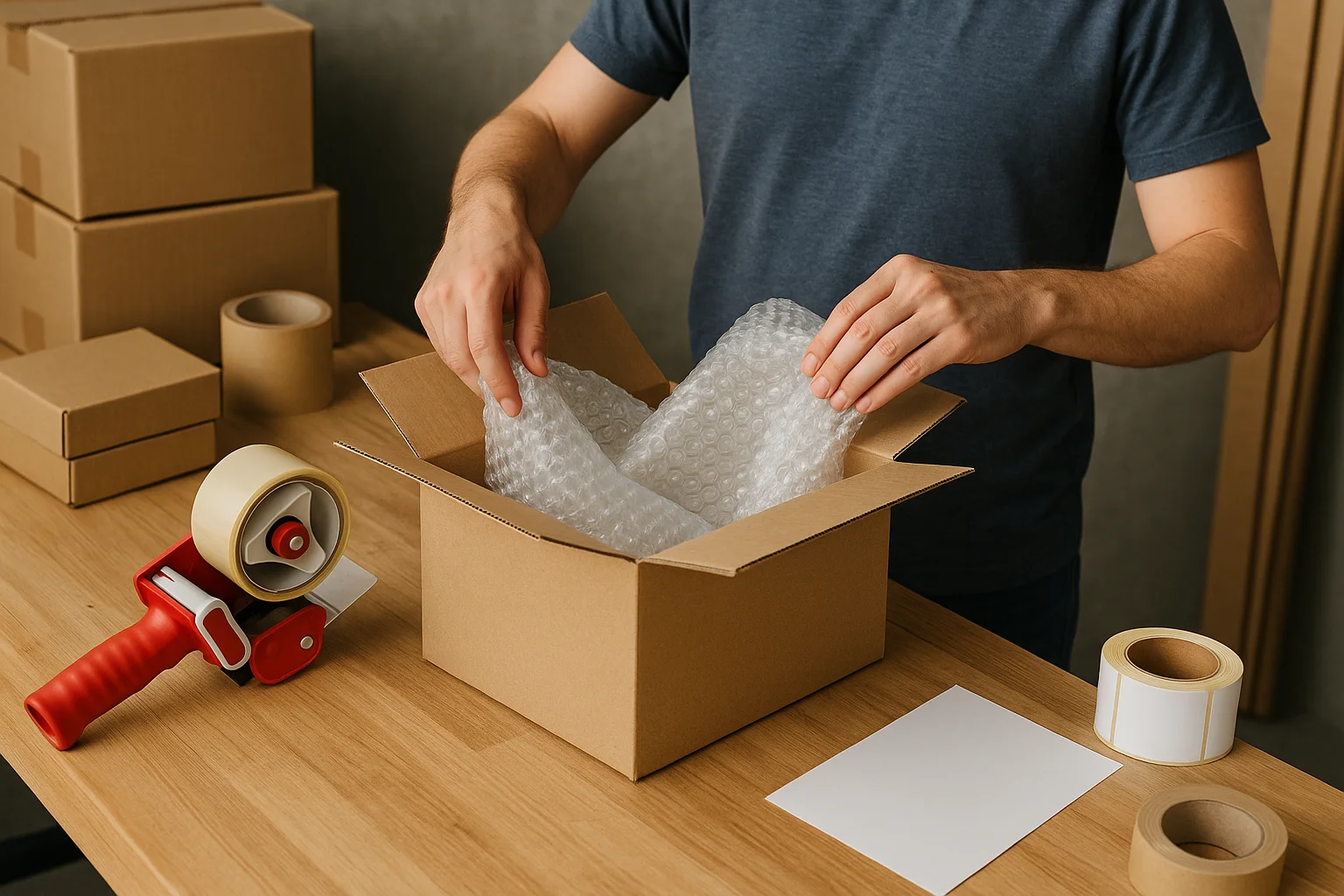Preparing and sending packages across state lines may seem daunting at first, but by following a systematic approach, you can ensure your items arrive safely, on time, and without unexpected fees. This guide covers every step-from selecting the right materials to choosing a carrier and understanding regulations-so you can ship boxes with confidence.
Key Takeaway
Proper packing and informed carrier selection are essential to protect your items, minimize shipping costs, and avoid delays. Focus on sturdy materials, strategic cushioning, accurate labeling, and compliance with carrier guidelines for a smooth shipping experience.
1. Selecting the Right Packaging Materials
Choosing appropriate packaging materials lays the foundation for safe shipping. Every component-from the box itself to the cushioning-contributes to protecting your items.
1.1. Box Selection
- Sturdy Corrugated Boxes Use double-wall corrugated boxes for heavy or fragile items; single-wall boxes suffice for lightweight, non-breakable goods.
- Size Considerations Select a box slightly larger than the item(s) to accommodate cushioning. Aim for at least 2–3 inches of space on all sides. Oversized boxes increase dimensional weight and shipping costs.
1.2. Cushioning and Void Fill
- Primary Cushioning Wrap fragile items in bubble wrap or foam sheets. Ensure all surfaces are covered with at least one layer.
- Secondary Cushioning Use packing peanuts, crumpled kraft paper, or air pillows to fill empty space. Prevent items from shifting by snugly filling voids.
- Specialty Materials For extremely fragile or irregularly shaped objects, consider foam-in-place packaging or molded pulp inserts.
1.3. Sealing Supplies
- Packaging Tape Invest in a high-quality, pressure-sensitive polypropylene or polyester tape at least 2 inches wide. Avoid duct tape or masking tape as they can fail under stress.
- Strapping and Bands For heavier boxes, using plastic or steel banding adds security and prevents bulging.
- Edge Protectors Cardboard or plastic edge protectors safeguard corners and help distribute pressure.
2. Packing Techniques for Maximum Protection
How you pack items inside the box is as important as the materials themselves. Follow these step-by-step techniques to optimize protection.
2.1. Layering Strategy
- Bottom Layer: Add 2–3 inches of cushioning material.
- Item Placement: Center your wrapped items on the cushioning. Keep heavier items on the bottom if multiple objects are packed.
- Filling Voids: Surround each item with cushioning so there is no direct contact between objects or with the box walls.
- Top Layer: Cover the items with another 2–3 inches of cushioning.
2.2. Wrapping Fragile Components
- Individual Wrapping: Wrap each breakable piece separately. Secure bubble wrap layers with small pieces of tape.
- Bundling Small Parts: Seal tiny pieces in resealable plastic bags to prevent loss. Then wrap the bundle.
- Labeling Fragiles: Use “Fragile” labels, but remember these are only advisory-proper internal packing is what truly safeguards contents.
2.3. Sealing Your Box
- Place tape across both side seams at the top flap.
H-Taping Method:
Run a strip of tape along the center seam.
Repeat on the bottom of the box. This H-shape ensures all openings are reinforced.
Edge Reinforcement: Apply tape at corners and edges for added strength.
3. Labeling and Documentation
Proper labeling and completing necessary documentation reduces the chance of misrouting and ensures smooth delivery.
3.1. Shipping Label
- Clear Address Format
- Recipient Name
- Street Address or P.O. Box
- City, State, ZIP Code
- Return Address in the upper left corner
- Legible Barcode Area Leave a 4×4 inch area free of tape, writing, or labels for barcodes or tracking stickers.
3.2. Special Handling Labels
- Fragile
- This Side Up
- Keep Dry
Affix labels on multiple sides when necessary, ensuring they’re visible and unwrinkled.
3.3. Customs and Regulatory Forms (If Applicable)
Shipping across state lines in the U.S. generally does not require customs forms. However, be aware that certain items may be restricted or subject to additional regulations:
- Hazardous Materials (HazMat)
- Alcohol or Tobacco
- Lithium Batteries
Consult carrier guidelines for any extra paperwork or labeling requirements.
4. Choosing a Shipping Carrier and Service
Your choice of carrier and service level impacts cost, speed, and reliability. Compare options before committing.
4.1. Major U.S. Carriers
| Carrier | Service Levels | Transit Time (Typical) | Tracking & Insurance |
|---|---|---|---|
| USPS | First-Class, Priority, Media Mail, Retail Ground | 2–5 days (Priority) | INCLUDED; limited insurance |
| UPS | Ground, 2-Day Air, Next Day Air | 1–5 days (Ground) | INCLUDED; extra for high value |
| FedEx | Ground, Express Saver, Overnight | 1–5 days (Ground) | INCLUDED; extra for high value |
4.2. Evaluating Costs
- Weight vs. Dimensional (DIM) Weight Carriers charge by actual weight or DIM weight (box volume ÷ DIM divisor), whichever is greater. To minimize DIM charges, use appropriately sized boxes.
- Additional Fees
- Residential Delivery
- Saturday Delivery
- HazMat or Oversized
4.3. Insurance and Declared Value
- Most carriers include minimal insurance (e.g., $50 for USPS Priority) but allow you to declare higher values for an additional fee. Always declare the true replacement value for valuable items.
5. Shipping Process: Step by Step
Following a clear workflow helps you avoid mistakes and delays.
- Gather Materials Boxes, cushioning, tape, labels, pens, scale, and measurement tools.
- Weigh and Measure Use a digital scale and measuring tape. Record weight in pounds (lbs) and dimensions in inches (length × width × height).
- Complete Labels and Forms Write or print the shipping label. Attach special handling labels.
- Pay for Postage
- Online (carrier website): Offers discounted rates and convenient pickups.
- In-Store: Pay at the carrier’s retail location; often higher rates.
- Schedule Pickup or Drop-Off
- Pickup: Many carriers offer free or low-cost pickup for online shipments.
- Drop-Off: Leave at a local post office, UPS Store, FedEx Office, or designated drop box.
- Track and Confirm Delivery Monitor tracking updates online. If any issue arises, contact the carrier with your tracking number ready.
6. Special Considerations for Interstate Shipping
Shipping from one state to another introduces a few extra factors to watch.
6.1. Distance and Transit Times
- Long distances may increase transit times by 1–2 days for ground services.
- Consider expedited services if time-sensitive.
6.2. Weather-Related Delays
- Seasonal weather can cause holdups, especially in winter or hurricane season.
- Check carrier service alerts for real-time updates.
6.3. State-Specific Restrictions
- Some states have unique rules on importing certain goods (agricultural products, live plants, perishables).
- Verify with the destination state’s department of agriculture or relevant agency.
6.4. Bulk and Business Shipping
- If shipping multiple boxes or setting up regular shipments, look into freight services or business accounts with carriers for volume discounts.
- Palletizing multiple boxes can reduce cost per unit and simplify handling.
7. Eco-Friendly Packing and Shipping Tips
Increasingly, shippers seek to minimize environmental impact without sacrificing protection.
- Recycled Boxes and Materials Purchase post-consumer recycled boxes.
- Biodegradable Packing Peanuts Made from starch, dissolve in water without harmful residues.
- Reusable Packaging Encourage recipients to return sturdy containers for reuse.
- Minimize Void Fill Plan box size precisely to reduce excess air space and material usage.
8. Troubleshooting Common Issues
Even with careful preparation, problems can arise. Here’s how to address the most common concerns:
| Issue | Possible Cause | Solution |
|---|---|---|
| Box arrives crushed | Insufficient strength or poor stacking | Use double-wall boxes, reinforce seams |
| Items shift inside package | Inadequate cushioning or void fill | Add more cushioning, use dividers |
| Tape peels off | Low-quality tape or improper sealing | Switch to heavy-duty packaging tape |
| Incorrect postage fees | DIM weight not calculated or label error | Reweigh, remeasure, reprint label |
| Lost or delayed shipment | Label damaged or misrouted, weather events | File carrier claim, track with tracking number |
Conclusion
Shipping boxes safely and efficiently across state lines involves thoughtful material selection, precise packing techniques, accurate labeling, and informed carrier choices. By investing time upfront to pack properly and understand the cost factors-such as dimensional weight, insurance, and special fees-you minimize the risk of damage, delays, and unexpected expenses. Whether you’re sending a single personal package or coordinating bulk business shipments, following the steps outlined in this guide will streamline your shipping process and ensure your items reach their destination in excellent condition.



Leave a Reply